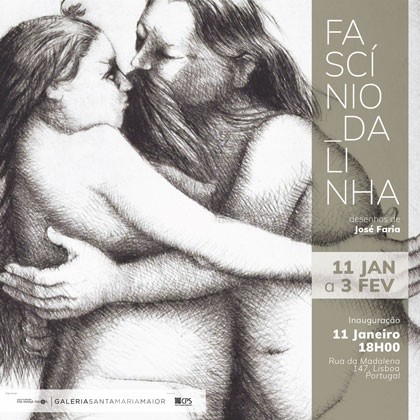
Exhibition "Fascínio da Linha" by José Fari
The Santa Maria Maior Gallery, in partnership with the Portuguese Screen Printing Center, presents the exhibition “Fascínio da Linha”, an exhibition of drawings and engravings by the plastic artist and engraver José ; It would be part of the edition of the book with the same name, an edition by the Portuguese Center for Serigraphy, based on Canto IX of Os Lusíadas by Luís Vaz by Camões, A Ilha dos Amores.
With a studio based there for many years in the parish of Santa Maria Maior, José Faria, master of drypoint, professor of drawing, engraving and painting, handwritten the poem in period handwriting and created 12 engravings that explore the virtues of drypoint and etching techniques, including the frontispiece ;cio and a loose engraving, in which, according to linguist Isabel Hub Faria who prefaces the book, the “artist simultaneously captures the fleeting erotic adventure and the historical character of the journey, his heroes and the fantastic characters”. The result is a refined and representative set of Joséé I would.
In the preface you can also read:
“Anyone who has enjoyed the complex sensation, simultaneously tactile and sonorous, of tearing a sheet of copper with a dry point or a burin understands how, alongside the cognitive nature of conceptualization; o, the entire body of the engraver is physically involved in the dexterity, in the fine control of the force to be applied, in the motor reverberation of a deeper groove, in the subtle vibration along the path of the simplest line . Once the line is imagined, the execution assumes the inevitability of the mark it leaves.
A line that is rejected may be patiently erased, but its mark remains in memory.
The experience of engraving with a dry point is thus similar to that of engraving. of a unique, initial and pure sensation that, on the one hand, is represented in the image produced and, on the other, is inscribed as a connection in the permanent memory of its author. It is therefore understandable that the risk in copper is combined with the fascination of the line, like an imagined adventure that does not end in its planning. Fascination is Try it, in this case, draw it and feel it.
(…) By offering us this Fascínio da Linha for trial, José Faria invites us to travel beyond this Canto, opening yet another path for the recognition of all his work.”
Patent up to February 3.
Santa Maria Maior Gallery
Rua da Madalena 147, Lisbon
Monday to Saturday, between 3pm and 8pm.